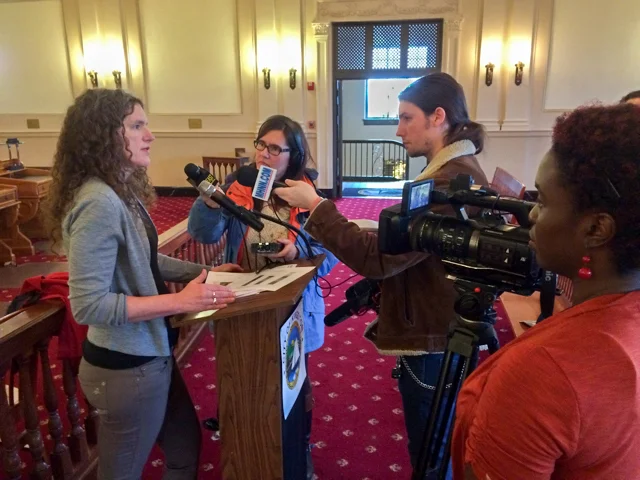In March, the PSC is expected to consider a proposal by DPS Staff to revamp how customers of local renewable projects are compensated for their power, effectively ending the current system of net-metering credits for new local projects that serve multiple community members, as well as projects serving municipal, large-commercial and industrial customers. Instead, customers of these projects would receive monetary compensation that is intended to take into account the “actual value” of the project to the grid and, to a much lesser extent, the environment. This new methodology is referred to as the “Value of Distributed Energy Resources” or “VDER,” for short.
For smaller on-site projects serving residential and small commercial customers, net-metering will remain in effect for new projects until 2020. All existing projects, large and small, would be grandfathered in and would continue to receive net-metering credits for 20 years.
At a press conference tomorrow, local officials, local solar developers, and CLP will discuss plans for local projects that would be impacted by the new compensation scheme, and will urge the Governor and the PSC to ensure that any policy changes affecting compensation for these types of projects supports, and does not hinder, the development of local renewable resources in line with the State’s energy goals.
The immediate impact of the change would be to cause a drop in the value of the energy produced by community renewable projects, as the DPS Staff proposal acknowledges. (As discussed further below, “market transition credits” will be made available in limited supply to help mitigate a steep drop in value relative to net-metering for community renewables.) The change in compensation to customers will also mean that the value for the power will fluctuate hour-to-hour and day-to-day. Currently, the policy of net-metering fixes the value to the customer over the life of the project: a credit from the power produced can be used to purchase a kwh of retail power, regardless of the price of energy at the time. Under the new system, the monetary credit for the power could be higher or lower than the price of a kwh at any point in time. The idea behind the policy change is to more accurately price the energy according to the value of the project to the system, based on its location on the grid and the time in which it produces power.
CLP is very concerned that the immediate impact of this State policy change will be to discourage investments in community and municipal renewable projects that would benefit the local economy, taxpayers, and electricity customers that currently have no access to the benefits of renewable energy. While we support the PSC’s goal of encouraging renewable energy investments where they make the most sense from a grid perspective, there are other very good reasons to encourage the development of these kinds of local renewable projects.
In 2015, at the initiative of Governor Cuomo, the PSC enabled Community Distributed Generation in the state, which allows multiple customers to receive net-metering credits for a renewable project sited anywhere in their service territory—as if it were on their roof. The policy change made the benefits of renewable energy much more broadly accessible, enabling participation by renters, low- and moderate-income families, and residents and businesses whose buildings are poorly sited for renewable generation. Few community projects have yet to be installed, and community-based organizations and solar companies are worried that the new policy could increase the perceived risk of these projects and make them much more difficult to finance. It will also reduce the compensation to would-be customers of these projects from the energy produced.
DPS Staff have also acknowledged in their proposal that they have not yet produced a valuation methodology that includes all the potential values of a project to the distribution system. In recognition that more work needs to be done to properly value these renewable resources, the proposal divides implementation into phases. In Phase 1, which would begin as soon as the policy is adopted, eligible community renewable projects could receive a transition credit aimed at mitigating the steep drop in compensation to customers for community projects by bringing the value closer to the value currently received through net-metering. No credits are planned for Phase 2, which would begin in two years. Remote net-metered projects and projects by large electricity customers would not be eligible for these credits.
CLP and other organizations are asking the PSC to:
1) Maintain net-metering for the next two years and allow projects to opt-in to the new compensation regime if they choose. See how it is working and give the market time to adjust, especially given that the new compensation scheme is a work-in-progress. Uncertainty hurts investment, and wrenching change could have a deleterious impact on non-grandfathered projects.
2) Modify the proposal in order to reduce the variability in compensation over the life of a project to provide the predictability and certainty needed for obtaining project
3) Take ALL benefits to the distribution system into account; a partial account will end up devaluing the contribution of local renewable projects, and will favor large-scale fossil fuel production and long-distance transmission rather than local, cleanly produced energy that benefits communities and the environment.
4) Take other “locational” values into account besides grid costs and benefits, like the value to taxpayers, communities, and the environment of siting renewable projects on brownfields, such as former landfills.
The Energy Democracy Alliance submitted comments to the PSC signed by 98 organizations (including CLP), elected officials and businesses from across the state, calling on the PSC to make improvements to the proposal and to slow the transition so as not to disrupt the very nascent community solar market.
The Alliance for a Green Economy has prepared a guide to help citizens understand this complex proposal, which you can find here.
Take action! You can submit public comments directly on the DPS website. Just click on “post comments” just above the case number on the right-hand side of the page.

